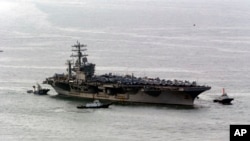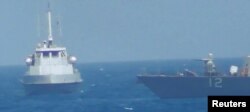The Pentagon on Saturday strongly countered Iran's claim that a U.S. Navy aircraft carrier had fired warning shots at one of its ships in an "unprofessional" manner.
Iran's official IRNA news agency quoted a statement from the Revolutionary Guard as saying the incident occurred Friday when the USS Nimitz approached an offshore oil platform in the Persian Gulf and a helicopter from the ship buzzed a boat carrying Iranian soldiers.
Navy spokesman Lieutenant Ian M. McConnaughey said Saturday, "While conducting a routine patrol in the international airspace of the Arabian Gulf on July 28, a U.S. Navy helicopter observed several Islamic Revolutionary Guard Corps naval vessels approaching U.S. naval forces at a high rate of speed. U.S. naval forces attempted to establish communications, with no response from the Iranian vessels. Shortly thereafter, at a safe distance, the U.S. helicopter deployed flares, after which the Iranian vessels halted their approach.
"Following communications, the Iranian vessels were observed conducting a gun exercise.
"U.S. Naval Forces Central Command assesses the interaction as safe and professional."
The confrontation was the second such incident this week. On Tuesday, a U.S. ship fired warning shots at an Iranian vessel in the Gulf after sailors on the ship said it had approached them in a threatening manner.
Iran denied approaching the U.S. ship Tuesday and said it was the U.S. ship that had been acting in a threatening way.
Dust-ups between U.S. and Iranian vessels have happened fairly regularly in recent months. In January, a U.S. destroyer fired warning shots at four Iranian boats in the Strait of Hormuz as they approached at high speed.
Rocket launch
This most recent confrontation between U.S. and Iranian militaries came just a day after Iran said it had successfully launched a rocket carrying a satellite into space.
State television in Iran claimed Thursday that the Simorgh rocket, which means "phoenix" in Farsi, was capable of carrying a 250-kilogram satellite as far as 500 kilometers above Earth, but did not elaborate on the kind of satellite.
The U.S., Britain, France and Germany issued a joint statement denouncing the rocket launch, calling it “destabilizing” for the region.
Prior to the launch of the satellite, the U.S. moved earlier this month to increase economic sanctions on Iran over its ballistic missile program.
The launch did not violate the 2015 nuclear agreement, which was signed by Iran and the P5+1 group of world powers — the five permanent members of the U.N. Security Council, plus Germany — although the U.S. has expressed concern that the rocket technology being developed by Iran could potentially be adapted to long-range missiles.


